So floods
create gold?

I realize the flood "replenishment" theory is popular but a better perspective might be that gold sometimes is moved from one place to another. Where it ends up is a valid question for prospecting but a more profitable answer will be found in "where does it move from and why does it move?"
Placer gold deposits tend to be small and scattered. Water concentrated deposits even more so. Rarely is the source of the gold actually in the bed of the stream. The gold has to be moved from where it eroded out of the mother rock and moved to a place where it naturally concentrates. There has been a lot more gold mined "in place" in the original hard rock deposit than in the placers created by the erosion of those hard rock deposits. Following that moving eroded gold to it's settling place is difficult at best. Add in all the myths and theories you find on public forums and old books can be very frustrating. Just a little real knowledge about gold movement can give a placer miner a big advantage.
Understanding slope and flow dynamics will show you
how gold moves. Not the most popular subject here but the answers it reveals will cause you to drop your current replenishment theories like a hot potato.
There has been much less science applied to placer deposit mechanics than hard rock deposits. There are resources but you just need to look a little harder. New knowledge is being revealed regularly but seldom is the subject strictly related to gold.
Here's some research that's being carried out at Caltech.
Read and understand that short article and you will see that the theories about gold movement "replenishment" found on this and other forums doesn't really work in real life. It's not flooding that brings new gold into waterways it's slope failure (landslides). Gold being the last mineral to move makes this knowledge even more important to the gold prospector.
From the above article:
"In very steep streambeds with a 22-degree or higher slope, sediment motion begins not with grains skipping and bouncing along the bottom of the streambed, but rather with a complete bed failure in which all the sediment is abruptly sent hurtling downstream as a debris flow."
This is a 22[SUP]o[/SUP] slope:

There is a video on that linked page. You can read the paper the article is based on but you will need a subscription to
Geology Magazine. The paper is titled
Incipient sediment motion across the river to debris-flow transition and it's in the March 2014 publication. You might find it at a good library if the cost of a subscription is too much money.
Here's another paper demonstrating that the idea that faster water flows create greater sediment movement isn't necessarily true.
Turbulence characteristics in unsteady and non-uniform flows and their impacts on the incipient motion of sediment transport-water resources-river mechanics That paper can be downloaded here.
Educate yourself and prosper!

Heavy Pans






 . Moss tells the story pretty well up there. A few weeks ago I was up running my sniper and had a fella who owns the property opposite where I was digging offer me his sluice box, because mine was so small!! Very nice guy.
. Moss tells the story pretty well up there. A few weeks ago I was up running my sniper and had a fella who owns the property opposite where I was digging offer me his sluice box, because mine was so small!! Very nice guy.
